
Hetmans of the Polish–Lithuanian Commonwealth were the highest-ranking military officers, second only to the King, in the Polish–Lithuanian Commonwealth. The first Polish title of Grand Crown Hetman was created in 1505. The title of hetman was given to the leader of the Polish Army and until 1581 it was awarded only for a specific campaign or war. Later it became a permanent title, as did all the titles in the Kingdom of Poland and Polish–Lithuanian Commonwealth. It could not be revoked unless treachery had been proven. Hetmans were not paid for their services by the Royal Treasury.

The Duchy of Samogitia was an administrative unit of the Grand Duchy of Lithuania from 1422. Between 1422 and 1441 it was known as the Eldership of Samogitia. The Grand Duke of Lithuania also held the title of Duke of Samogitia, although the actual ruler of the province, responsible to the Duke, was known as the General Elder (Seniūnas) of Samogitia.

The Battle of Wiłkomierz took place on September 1, 1435, near Ukmergė in the Grand Duchy of Lithuania. With the help of military units from the Kingdom of Poland, the forces of Grand Duke Sigismund Kęstutaitis soundly defeated Švitrigaila and his Livonian allies. The battle was a decisive engagement of the Lithuanian Civil War (1432–1438). Švitrigaila lost most of his supporters and withdrew to southern Grand Duchy; he was slowly pushed out and eventually made peace. The damage inflicted upon the Livonian Order has been compared to the damage of Battle of Grunwald upon the Teutonic Order. It was fundamentally weakened and ceased to play a major role in Lithuanian affairs. The battle can be seen as the final engagement of the Lithuanian Crusade.

Stanislovas Kęsgaila Jonaitis was a Lithuanian nobleman, son of Jonas Kęsgaila from the Kęsgailos family. Stanislovas Kęsgaila was the Elder of Samogitia (1486–1522), Grand Hetman of Lithuania (1501–1502), castellan of Trakai (1499–1522) and Vilnius (1522–1526).
Stanislovas Kęstgaila (1503–1532) was a Lithuanian nobleman, son of Stanislovas Kęsgaila from the Kęsgailos family. Stanislovas Kęstgaila was the Elder of Samogitia (1527–1532) and castellan of Trakai (1528–1532). After marriage to Anna, daughter of Stanisław Kiszka, Stanislovas was the wealthiest magnate in the Grand Duchy of Lithuania.
The Muscovite–Lithuanian Wars were a series of wars between the Grand Duchy of Lithuania, allied with the Kingdom of Poland, and the Grand Duchy of Moscow, which would later become the Tsardom of Russia. After several defeats at the hands of Ivan III and Vasily III, the Lithuanians were increasingly reliant on Polish aid, which eventually became an important factor in the creation of the Polish–Lithuanian Commonwealth. Before the first series of wars in the 15th century, the Grand Duchy of Lithuania controlled vast stretches of Eastern European land, from Kyiv to Mozhaysk, following the collapse of Kievan Rus' after the Mongol invasions. Over the course of the wars, particularly in the 16th century, the Muscovites expanded their domain westwards, taking control of many principalities.
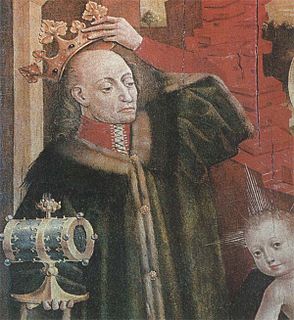
The Ostrów or Astrava Agreement was a treaty between Jogaila, King of Poland and Grand Duke of Lithuania, and his cousin Vytautas the Great, signed on 4 August 1392. The treaty ended the destructive Lithuanian Civil War, launched in 1389 by Vytautas who hoped to gain political power, and concluded the power struggle between the two cousins that erupted in 1380 after Jogaila secretly signed the Treaty of Dovydiškės with the Teutonic Knights. The Ostrów Agreement did not stop attacks from the Teutonic Knights and the territorial dispute over Samogitia continued up to 1422. According to the treaty, Vytautas became the ruler of Lithuania, but he also acknowledged Jogaila's rights to Lithuania. The details of the Polish–Lithuanian relationship were clarified in several later treaties, including the Union of Vilnius and Radom in 1401 and Union of Horodło in 1413.
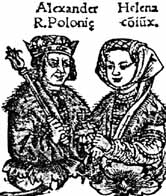
Helena Ivanovna of Moscow was daughter of Ivan III the Great, Grand Prince of Moscow, and an uncrowned Grand Duchess of Lithuania and Queen of Poland as she would not convert from Eastern Orthodoxy to Catholicism. Her childless marriage to Grand Duke of Lithuania and later King of Poland Alexander Jagiellon was a constant source of tension between the Grand Duchy of Moscow and the Grand Duchy of Lithuania. Instead of guaranteeing peace, Helena's marriage gave her father Ivan III an excuse to interfere in Lithuanian affairs accusing Alexander of mistreating Helena and repressing Orthodox believers. This became the pretext to renew the Muscovite–Lithuanian Wars in 1500. The war ended with a six-year truce in 1503; the Grand Duchy of Lithuania lost about a third of its territory. Despite political tensions and religious differences, the marriage was a loving one and the royal couple was close. After her husband's death in 1506, Helena wanted to return to Moscow but was not allowed. When she planned to run away, she was arrested and reportedly poisoned.
The Battle of Ula or Battle of Chashniki was fought during the Livonian War on 26 January 1564 between the Grand Duchy of Lithuania and the Tsardom of Russia on the Ula River north of Chashniki in the Vitebsk Region. The Russian troops, unarmed and moving in a loose formation, were taken by complete surprise and defeated, losing their large wagon train.

The siege of Polotsk was laid in 1518 by forces of the Grand Duchy of Moscow on Polotsk during the Fourth Muscovite–Lithuanian War (1512–1522). The Lithuanians defended the city. According to a legend, Prince Casimir Jagiellon appeared before the Lithuanian troops and helped them to achieve victory. It was the first miracle attributed to Casimir, which perpetuated his cult and led to his eventual canonization.
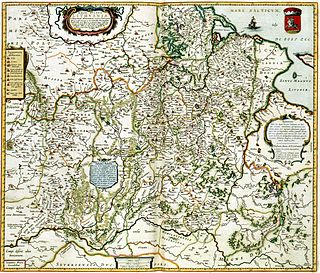
The history of Lithuania between 1219 and 1295 concerns the establishment and early history of the first Lithuanian state, the Grand Duchy of Lithuania. The beginning of the 13th century marks the end of the prehistory of Lithuania. From this point on the history of Lithuania is recorded in chronicles, treaties, and other written documents. In 1219, 21 Lithuanian dukes signed a peace treaty with Galicia–Volhynia. This event is widely accepted as the first proof that the Baltic tribes were uniting and consolidating. Despite continuous warfare with two Christian orders, the Livonian Order and the Teutonic Knights, the Grand Duchy of Lithuania was established and gained some control over the lands of Black Ruthenia, Polatsk, Minsk, and other territories east of modern-day Lithuania that had become weak and vulnerable after the collapse of Kievan Rus'.
Alekna Sudimantaitis was an influential Lithuanian noble of Trąby coat of arms, Grand Chancellor of the Grand Duchy of Lithuania (1478–1490) and Voivode of Vilnius (1477–1490).

Stanisław Piotrowicz Kiszka was a noble, diplomat and military commander from the Grand Duchy of Lithuania. He became the progenitor of the prominent Kiszka family. He was sent on frequent diplomatic missions to the Grand Duchy of Moscow and Kingdom of Poland. He attempted to negotiate peace during the Muscovite–Lithuanian Wars and supported a closer union between Poland and Lithuania. During the Second Muscovite–Lithuanian War (1500–03), he successfully defended Smolensk and became Great Hetman until Konstanty Ostrogski escaped Russian captivity in 1507. Kiszka helped to subdue the Glinski rebellion in 1508. Shortly before his death, Kiszka also became Grand Marshal of Lithuania.
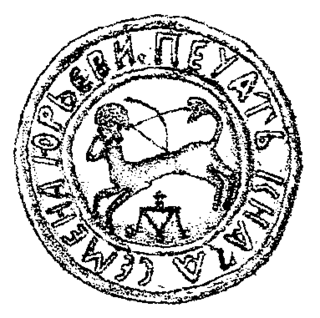
Prince Semyon Yurievich of Halshany was a noble from the Olshanski family in the Grand Duchy of Lithuania.

Piotr Kiszka was a noble of the House of Kiszka from the Grand Duchy of Lithuania. According to the military census of 1528, he was the 10th wealthiest magnate in the Grand Duchy. In case of war he had to provide 224 fully equipped cavalrymen to the army. That meant that he had more than 23,000 peasants in his dominions.
Petras Jonaitis Mantigirdaitis was a prominent noble of the Grand Duchy of Lithuania. Grandson of Petras Mantigirdaitis, he first appeared in written sources in 1476 and reached his career high in 1490s when he was Voivode of Trakai (1490–97) and Grand Marshal of Lithuania (1491–97).
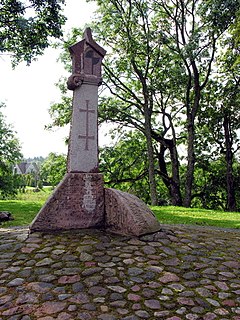
The Fatherland Defense Force or Kampfgruppe Mäder was a short-lived military unit hastily formed in northwestern Lithuania towards the end of World War II to combat approaching Soviet forces. Formed from local Lithuanians, the unit was directly subordinate to the Wehrmacht. Their German commander was Hellmuth Mäder who was hoping to raise a division. However, only two ill-equipped and ill-trained regiments were actually formed. The total membership is estimated at 6,000 men. On October 7, TAR took defensive positions in Seda against the 19th Tank Corps of the 6th Guards Army. TAR suffered heavy losses and retreated towards Klaipėda (Memel). In East Prussia, the remaining men were reassigned to various pioneer units.

The Lithuanian–Muscovite War, known in Russia as Litovschina encompasses three raids by Algirdas, Grand Duke of Lithuania, to the Grand Duchy of Moscow in 1368, 1370, and 1372. Algirdas organized the raids against Dmitry Donskoy in support of the Principality of Tver, chief rival of Moscow. In 1368 and 1370, Lithuanians besieged Moscow and burned the posad, but did not succeed in taking the city's Kremlin. In 1372, the Lithuanian army was stopped near Lyubutsk where, after a standoff, the Treaty of Lyubutsk was concluded. Lithuanians agreed to cease their aid to Tver, which was defeated in 1375. Mikhail II of Tver had to acknowledge Dmitry as "elder brother".
The siege of Smolensk was an unsuccessful attempt to capture Smolensk by the forces of the Grand Duchy of Moscow in summer 1502. It was the last major military engagement during the Muscovite–Lithuanian War (1500–1503).











